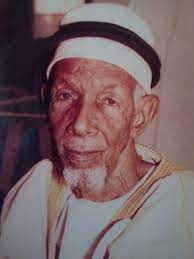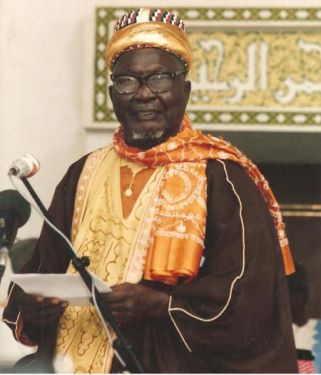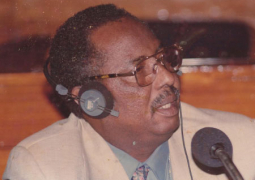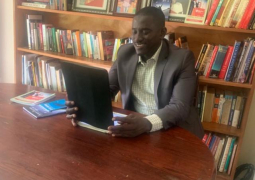
In 1992, Sheikh Abu Bakr Zaidy Jallow, Imam of Bansang (Gambia), published a book in Arabic entitled "Bughyat Al-Sa'il Wa Ghunyat Al-Aqil" (124 pages) at the International Islamic University Press in Islamabad, Pakistan. This text is published with the English translation (106 pages) under the title The Desire of the Enquirer and the Wealth of the Wise. Muhamad Faizanur Rahman made the English translation at the request of the late Sulaiman M.B. Faye.
The book is prefaced by Dr Mahmood A. Gazi, Director of Da'wah Academy. This institution aims to provide a high level of theological education to Muslim students and promote religious publications in different languages worldwide. In addition, the Imam Ratib of Banjul, Abdoulie Jobe, also added a brief introductory note.
The author reports on the fundamental principles of Islam, especially on all the rules of Islamic jurisprudence, based on the Quran, the Hadiths and the books of the great Muslim theologians.
The book begins with an introductory presentation that recalls the essential dogmas of the Islamic faith. Then the reader will discover a great deal of concrete and detailed information on how to conform one's life to the Sharia, the set of rules that govern the behaviour of each faithful. However, what confuses the reader at the beginning is that the book is not composed in chapters, but it unfolds a series of eighty points or important questions that are not numbered and go from a few lines to five pages. Thus, there are no less than twenty-seven points for the various prayers that deal in detail with the gestures, words and attitudes the believer should observe - always regarding texts and Tradition. However, as with other matters, not all the prayers-related issues are grouped and may be found in different places. Information on mosques, funerals and death, the Pilgrimage to Mecca, charity duties, marriage, etc., can be found in other areas.
Reading requires a minimum of prior knowledge of Islamic practices and especially of the Arabic language used during the rites, as many explanations of words are given without the words being transcribed into English - so it is good to read Arabic and understand its meaning. This knowledge is commonplace for a Muslim to whom the book is addressed and should not be a hindrance. It will only confuse the reader who does not have a little prior knowledge of Arabic.
The Imam of Bansang, Zaidy Jallow, clearly has a great knowledge of jurisprudence. Every situation in the believer's life is linked to numerous facts and stories that justify and illustrate the rules of behaviour.
Like those of Abdoulie Jobe, this book bears witness to the deepening religious knowledge of Gambian Muslims.
 Alhagie Abdoulie M. Jobe - The Ideal Prophet
Alhagie Abdoulie M. Jobe - The Ideal Prophet
Abdoulie M. Jobe was born in 1910 in Bathurst. After his education, he joined the Post Office in 1931 as a telephone operator and served until his retirement in 1965, when he held the rank of Post Office Inspector. Alongside his training and professional work, he had an early interest in religious studies, which he began at seven. Throughout his life as a civil servant, he worked to deepen and perfect his knowledge of the Arabic language and Islamic studies. But when he retired, he could devote his time completely to his religious activities. He visited Saudi Arabia and obtained permission to stay in Medina for two years (1967-1968) to work on Islam. He wrote a 560-page document on Islamic Sciences in Arabic - a book widely distributed in the Muslim world and later translated into English by the author. A member of various religious associations in Banjul, he was a member of the executive committee of the Grand Mosque from 1964 and became its Iman Ratib in 1983. Alhagie Abdoulie Jobe has written texts on Islamic ethics and many religious subjects. He also wrote poems.
In 1997, he published a book on the life of the Prophet, The Ideal Prophet (Banjul, 173 pages), which seeks to provide a clear and concise set of essential information on the life and teaching of the Prophet. The book is divided into seven chapters. The first chapter presents some great prophets who preceded Muhammad (SAW): Ibrahim/Abraham, Musa/Moses, Isa/Jesus and Nuha/Noah. They form the lineage that the Prophet comes to complete and surpass. The next two chapters trace the major stages of Muhammad's life, from his childhood to his death, with the main stages of the formation of Islam and its expansion. The fourth chapter describes the exemplary behaviour of the Prophet throughout his life.
The fifth chapter summarises the main institutions established by the Prophet about (1) marriage and the status of women, (2) the social, economic and political system compatible with Islam, (3) the question of interest and profit, (4) the concept of sovereignty, (5) political values and (6) the notion of holy war (on which the author is very careful not to confuse the religious project with human justifications for expansion). Chapter six outlines the basic features of the Qur'an through which the Prophet gave the essence of the doctrine of Islam. At the same time, it indicates how the sacred text includes the data that Science is gradually discovering and how its literary form is inimitable. The last chapter concludes with the ideal aspect of the Prophet in terms of his life, behaviour, mission and work. A well-documented bibliography completes the book by Alhagie Abdoulie Jobe.
To be clear, without being simplistic and reductive, it is not an easy thing to do. It can be said that this book fulfils its purpose well: it will convince and enrich a believer with its remarks, which are always based on a careful study of the texts and commentators; it will inform synthetically a non-believer who wishes to understand the contribution and the considerable influence of Mohamed and Islam.
S.H.M. Jones The Diocese of Gambia and The Rio Pongas 1935- 1951
In 1985, the Bishop of The Gambia and the Rio Pongas, the Reverend Rigal Elisee, asked H.M.H for the jubilee of St Mary's Cathedral. Jones to write a brief history of the Anglican Church in The Gambia and Guinea. In 1986, he published a 66-page booklet, The Diocese of the Gambia and The Rio Pongas 1935-1951, with the subtitle Its origins and early history. The stop in 1951 is explained by the fact that, according to the 'thirty-year rule', S.M.H. Jones only had access to archives up to 1955. He also consulted newspapers, books, and various documents to reconstruct the main stages of this Anglican diocese.
The brochure is divided into nine parts. The first part recalls the various attempts, since 1460, to introduce Christian religions into the sub-region, the first Anglican having come for a few weeks in 1751. It was not until 1820, at the request of the Governor of Sierra Leone, Mac Carthy, that the first religions arrived, but illnesses took many of them away, so it was the Wesleyan Methodist Mission that took root first. In 1852, the Bishopric of Sierra Leone, which included The Gambia, was established. The Bathurst Anglicans, mostly from Sierra Leone, set up a school and church.
The second part relates to the creation of the Mission in Guinea. Set up in 1806, the Mission had to be closed because of the impressive number of deaths among the missionaries. With the help of the Mission of the West Indies, which was anxious to see a mission established in Africa, a church was recreated in December 1855 at Rio Pongas, not without difficulty. The Mission grew relatively quickly, but disease, natural disasters (damaging the church buildings several times), the arrival of the French in Guinea (closing the Mission's schools because they were taught in English) and financial difficulties made the survival of Mission perilous.
The third part shows how in 1877, it was decided to install a bishop in Bathurst, appointed by the Archbishop of Canterbury, who would take charge of Guinea and the English colony of The Gambia. After settling the financial issues of running the new diocese, the Revd J.C.S. Daly was consecrated Bishop of The Gambia and Rio Pongas on 4 April 1935 and arrived in Bathurst on Ascension Day, 31 May 1935. Through articles in the Gambia Echo and the Diocesan Magazine of the time, the author reports on the arrival of the bishop (part four) and the enthronement ceremony at St Mary's Pro-Cathedral (part five). Part 6 gives an account of the bishop's objectives based on a report he wrote. Parts 7 and 8 show the development of the Mission until the Second World War. The last part focuses on the period 1940-1951. Military obligations for the clergy, and the closure of the borders of Guinea under the administration of the Vichy Government, which imprisoned Anglican priests, dealt a heavy blow to the Mission. After the war, the government's decision to control public schools did not simplify the situation. However, the emergence of local clergy, including Rev. Faye in the Gambia, gave a new impulse to the Mission. 1951, the date of the departure of Bishop Daly, replaced by the Reverend R.N. Coote, marked a new stage in the history of the Anglican diocese.



